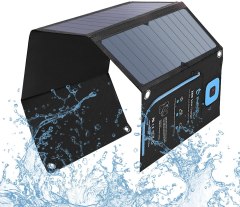BestReviews is reader-supported and may earn an affiliate commission. Details

Performance in variable conditions makes this fold-out model an excellent companion.
Performance in variable conditions makes this fold-out model an excellent companion.
Delivers 28W of power to two 5V/2.4-amp ports; capable of charging devices fast. Works in partly cloudy conditions. Included ammeter provides instant output reading. Weather-resistant carrying case.
Clips for attaching to backpack are a bit flimsy. Reports of device failing after a few weeks/months of use.

A fold-out, 4-panel option with an ample battery, flashlight function, and attractive styling.
A fold-out, 4-panel option with an ample battery, flashlight function, and attractive styling.
Four-panel folding model boasts stored capacity of 25,000 mAh. Folds into compact size. Attractive case materials and design. IP65 water- and weather-resistant. Offers 2 USB ports and flashlight feature.
Works best when simply keeping it charged, not charging it fully from empty.

A steady and reliable option for smaller electronics.
A steady and reliable option for smaller electronics.
Rated at 21W to power two 2.4-amp USB ports. Lightweight and portable thanks to its folding storage case. Charges smartphones and small electronic devices well, users report.
Charges too slowly for some users, even in direct sunlight. Storage pocket in case can hold heat.

This rechargeable power bank is a great backup power source for smartphones and smaller devices.
This rechargeable power bank is a great backup power source for smartphones and smaller devices.
Capacity of 10,000 mAh; capable of recharging a smartphone at least twice. Offers USB-C inputs and outputs for compatibility with latest devices and standards. Also sports a flashlight and compass accessory.
Solar charging is slow. Needs to be charged by USB cable for full capacity.

This foldout model is one of the narrowest on the market and offers USB-C connections.
This foldout model is one of the narrowest on the market and offers USB-C connections.
Rated at 15W of power to output two 5-volt, 2.1-amp USB charging ports. Five monocrystalline panels fold up into a narrow pack to attach to a pack or frame. Comes with USB-C cable. IPX4 water-resistant.
Doesn't have a battery to store electricity. Some durability concerns.

We recommend these products based on an intensive research process that's designed to cut through the noise and find the top products in this space. Guided by experts, we spend hours looking into the factors that matter, to bring you these selections.

We live in a world where we rely heavily on our phones and other electronic devices. We use them to communicate, to enjoy entertainment, to get directions from point A to point B. One way to make sure you never run out of juice, no matter how far you are from a power outlet, is to invest in a solar charger.
Below, you’ll find our full guide to solar chargers. Read on to discover the benefits of solar chargers, the different types available, and important tips to help you maximize your investment. When you’re ready to buy, scroll on up to the top of this screen to view our most esteemed recommendations.

Why should you buy a solar charger? What are the benefits of owning one? We answer these questions below.
Solar chargers are useful for faraway excursions in which you won’t have access to electricity. Campers, hikers, and other outdoor fans can benefit from a solar charger.
Many modern solar chargers are extremely lightweight and portable. It’s easy to pack a solar charger and take it with you wherever you go.
Solar power is a completely renewable energy source. If you’re looking for an eco-friendly way to power your electronics, this is it.
If you like to spend a lot of time outdoors, you can charge your devices for free while doing something you enjoy.

You can find three main types of solar chargers on the market: monocrystalline, polycrystalline, and CIGS (which stands for "copper, indium, gallium and selenide") solar chargers.
Pros:
Monocrystalline solar chargers are rugged and durable. They tend to last longer than CIGS models.
As long as it's sunny out, monocrystalline solar chargers are the most effective variety.
Newer foldable monocrystalline solar chargers are fairly light and portable.
Cons:
Monocrystalline solar chargers aren't as lightweight or compact as CIGS chargers.
In partially shaded conditions, monocrystalline solar chargers aren't very effective.
Price: Basic low-power monocrystalline solar chargers start at less than $20. Powerful high-end models tend to cost $175 to $200.
Pros:
Polycrystalline solar chargers tend to be the most inexpensive option.
Most polycrystalline solar chargers are very durable and long-lasting.
Cons:
Polycrystalline solar chargers are similar to monocrystalline models, albeit slightly less efficient.
Price: We found basic micro polycrystalline solar panels for as little as $5 to $7, but they're not extremely powerful. You can get a stronger 40-watt model for around $50, though some powerful high-end options cost over $100.
Pros:
CIGS solar chargers are the most lightweight option available.
Since CIGS solar chargers are made from flexible fabric, they can be rolled up like a poster and put in a bag when not in use, making them very portable.
CIGS solar chargers are significantly more effective than monocrystalline and polycrystalline models in overcast and partially shady conditions.
Cons:
Due to their thinness, CIGS solar chargers aren't as durable or long-lasting as either crystalline type.
CIGS aren't as efficient as monocrystalline or polycrystalline solar chargers in sunny conditions.
Price: CIGS solar chargers can cost anywhere from $50 to $300, depending on their power and quality.

The wattage of a solar charger dictates how powerful it is and how quickly it will charge your devices. Basic solar chargers may pack less than five watts of power, whereas the most powerful units can yield 100 watts.
While a four- or five-watt charger can tackle your average smartphone, it will take three to four hours to get it to a full charge. Ideally, you should opt for at least a seven-watt charger for a single phone to speed up the charging time. If you plan to charge multiple smartphones at the same time, or if you're charging a power-hungry device like a tablet, consider a 15-watt charger. For a laptop, DSLR camera, or video-recording equipment, we recommend a solar charger with a minimum of a 30 watts.
The output power of a solar charger is measured in amps. Find out the best amperage for the devices you want to charge, and choose accordingly. If your charger has more than one port, the manufacturer may list the output power for all the ports combined or for each port individually. Be sure to double-check this spec to make sure you know what the manufacturer is referring to.
How important is the weight of your solar charger to you? If you'll only be using it on camping trips where you can drive right up to your pitching site, weight may not be of huge importance. But if you'll be taking it on multi-day hiking trips where you really want to keep the weight of your pack down, a lightweight solar charger would be the best option.
Most manufacturers give a rough idea of how long a solar charger needs to power an average device. Of course, the charge time will vary depending on a number of factors, including the battery size, the power requirements of the device you're charging, and how sunny it is.

Most solar chargers have a USB port (or several USB ports) for your charging cable, so you'll need a charging cable that plugs into a USB port on one end and into your device on the other. If this kind of charging cable isn't available for your device, you'll need an adaptor.
As a rule, the larger the surface area of your solar charger, the quicker and more powerful it will be.
Consider the durability of your chosen solar charger. If you'll be using yours often or exposing it to rugged conditions, look for a hardy one that can withstand some abuse.
Not all solar chargers require direct sunlight to work. CIGS chargers are still relatively effective on bright overcast days and in partial shade.

Q. Is a solar charger capable of charging multiple devices at once?
A. Many solar chargers come with multiple USB ports so you can charge several devices at the same time. This is ideal if you're going on a family trip and want just one charger for the whole party. However, be sure to consider the wattage of your chosen charger; a low-power charger will take a long time to charge more than one device.
Q. Can I recharge a device that uses a 12V cigarette port with a solar charger?
A. While you can get adaptors to charge a range of different devices that don't use a USB port, most solar chargers aren't capable of tackling items that charge from a 12V cigarette port.
Q. Does the listed weight of a solar charger include all cables, batteries, and other accessories?
A. The listed weight of a solar charger can sometimes be misleading. While you'd expect the listed weight to include all essential accessories, some manufacturers only list the weight of the panel itself. If weight is important to you, be sure to check what the listed weight includes.
Get emails you’ll love.
Learn about the products you’re wondering if you should buy and get advice on using your latest purchases.
